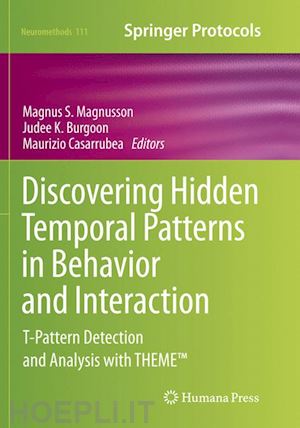
Questo prodotto usufruisce delle SPEDIZIONI GRATIS
selezionando l'opzione Corriere Veloce in fase di ordine.
Pagabile anche con Carta della cultura giovani e del merito, 18App Bonus Cultura e Carta del Docente
Preface.- Time and Self-similar Structure in Behavior and Interactions: From Sequences to Symmetry and Fractals.- Interactive Deception In Group Decision-Making: New Insights From Communication Pattern Analysis.- Imposing Cognitive Load To Detect Prepared Lies: A T-Pattern Approach.- Paraverbal Communicative Teaching T-patterns using SOCIN and SOPROX observational systems.- The Self-Organization of Self-Injurious Behavior as Revealed Through Temporal Pattern Analyses.- Detecting and Characterizing Patterns of Behavioral Symptoms of Dementia.- Typical errors and behavioral sequences in judo techniques: knowledge of performance and the analysis of T-patterns in relation to teaching and learning the Ouchi-gari throw.- Qualitative differences in men’s and women’s facial movements in an experimental situation.- Understanding Film Art: Moments Of Impact And Patterns Of Reactions.- Immersive Dynamics: Presence Experiences And Patterns Of Attention.- Accessing Individual Style Through Proposed Use Of Theme Associates.- Application Of T-Pattern Analysis In The Study Of Rodent Behavior: Methodological And Experimental Highlights.- Using Hidden Behavioral Patterns To Study Nausea In A Preclinical Model.- Informative Value Of Vocalizations During Multimodal Interactions In Red-Capped Mangabeys.- Identification And Description Of Behaviours And Domination Patterns In Captive Vervet Monkeys (Cercophitecus Aethiops Pygerythrus) During Feeding Time.- Tidal Location Of Atlantic Cod In Icelandic Waters And Identification Of Vertical And Horizontal Movement Patterns In Cod Behavior.- Complex Spike Patterns in Olfactory Bulb Neuronal Networks.











Il sito utilizza cookie ed altri strumenti di tracciamento che raccolgono informazioni dal dispositivo dell’utente. Oltre ai cookie tecnici ed analitici aggregati, strettamente necessari per il funzionamento di questo sito web, previo consenso dell’utente possono essere installati cookie di profilazione e marketing e cookie dei social media. Cliccando su “Accetto tutti i cookie” saranno attivate tutte le categorie di cookie. Per accettare solo deterninate categorie di cookie, cliccare invece su “Impostazioni cookie”. Chiudendo il banner o continuando a navigare saranno installati solo cookie tecnici. Per maggiori dettagli, consultare la Cookie Policy.